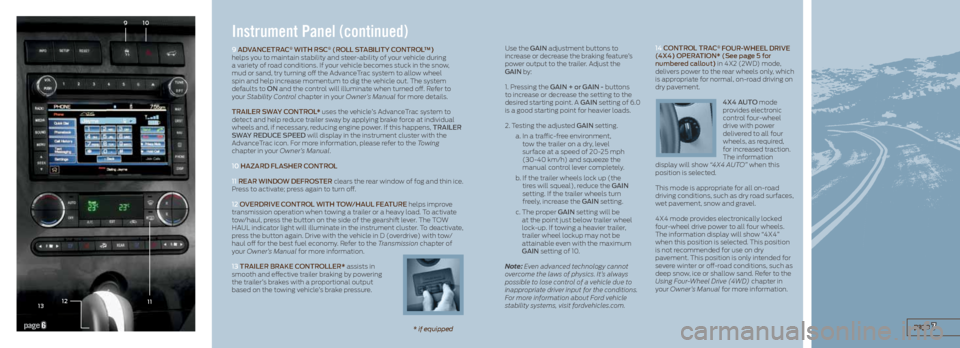traction control FORD EXPEDITION 2013 3.G Quick Reference Guide
[x] Cancel search | Manufacturer: FORD, Model Year: 2013, Model line: EXPEDITION, Model: FORD EXPEDITION 2013 3.GPages: 8, PDF Size: 0.94 MB
Page 4 of 8

Instrument Panel (continued)
9 adVanCetR aC® WItH R sC® (R oll staBIlItY C ontRol™)
helps you to maintain stability and steer-ability of your vehicle during
a variety of road conditions. If your vehicle becomes stuck in the snow,
mud or sand, try turning off the AdvanceTrac system to allow wheel
spin and help increase momentum to dig the vehicle out. The system
defaults to on and the control will illuminate when turned off. Refer to
your Stability Control chapter in your Owner’s Manual for more details.
tR aIleR s WaY C ontR ol* uses the vehicle’s AdvanceTrac system to
detect and help reduce trailer sway by applying brake force at individual
wheels and, if necessary, reducing engine power. If this happens, tR aIleR
s W aY Red UCe speed will display in the instrument cluster with the
AdvanceTrac icon. For more information, please refer to the Towing
chapter in your Owner’s Manual.
10 Ha ZaRd FlasHeR C ontRol
11 ReaR WIndo W deFRosteR clears the rear window of fog and thin ice.
Press to activate; press again to turn off.
12 o VeRdRIVe C ontRol WItH to W/HaUl FeatURe helps improve
transmission operation when towing a trailer or a heavy load. To activate
tow/haul, press the button on the side of the gearshift lever. The TOW
HAUL indicator light will illuminate in the instrument cluster. To deactivate,
press the button again. Drive with the vehicle in D (overdrive) with tow/
haul off for the best fuel economy. Refer to the Transmission chapter of
your Owner’s Manual for more information.
13 tR aIleR BR aKe ContRolleR* assists in
smooth and effective trailer braking by powering
the trailer’s brakes with a proportional output
based on the towing vehicle’s brake pressure.
11
910
page 7page 6* if equipped
12
13
Use the gaIn adjustment buttons to
increase or decrease the braking feature’s
power output to the trailer. Adjust the
gaIn by:
1. Pressing the gaIn + or gaIn - buttons
to increase or decrease the setting to the
desired starting point. A gaIn setting of 6.0
is a good starting point for heavier loads.
2. Testing the adjusted gaIn setting.
a. In a traffic-free environment,
tow the trailer on a dry, level
surface at a speed of 20-25 mph
(30-40 km/h) and squeeze the
manual control lever completely.
b. If the trailer wheels lock up (the
tires will squeal), reduce the gaIn
setting. If the trailer wheels turn
freely, increase the gaIn setting.
c. The proper gaIn setting will be
at the point just below trailer wheel
lock-up. If towing a heavier trailer,
trailer wheel lockup may not be
attainable even with the maximum
gaIn setting of 10.
Note: Even advanced technology cannot
overcome the laws of physics. It’s always
possible to lose control of a vehicle due to
inappropriate driver input for the conditions.
For more information about Ford vehicle
stability systems, visit fordvehicles.com. 14
ContR ol tR aC® F oUR-WHeel dRIVe
(4X4) opeR atIon* (see page 5 for
numbered callout) in 4X2 (2WD) mode,
delivers power to the rear wheels only, which
is appropriate for normal, on-road driving on
dry pavement.
4X4 aUto mode
provides electronic
control four-wheel
drive with power
delivered to all four
wheels, as required,
for increased traction.
The information
display will show “4X4 AUTO” when this
position is selected.
This mode is appropriate for all on-road
driving conditions, such as dry road surfaces,
wet pavement, snow and gravel.
4X4 mode provides electronically locked
four-wheel drive power to all four wheels.
The information display will show “4X4”
when this position is selected. This position
is not recommended for use on dry
pavement. This position is only intended for
severe winter or off-road conditions, such as
deep snow, ice or shallow sand. Refer to the
Using Four-Wheel Drive (4WD) chapter in
your Owner’s Manual for more information.